Chapultepec Castle
| Chapultepec Castle | |
|---|---|
Castillo de Chapultepec | |
 View of Chapultepec Castle from the East | |
 | |
| General information | |
| Architectural style | Neo-romanticism, Neoclassical, Neo-Gothic |
| Location | Miguel Hidalgo, Mexico City, Mexico |
| Elevation | 2,325 metres (7,628 ft) above sea level |
| Current tenants | Museo Nacional de Historia |
| Construction started | c. 1785 |
| Completed | 1864 |
| Height | 220 feet (67 m) |
| Design and construction | |
| Architect(s) | Eleuterio Méndez, Ramón Rodríguez Arangoiti, Julius Hofmann, Carl Gangolf Kayser, Carlos Schaffer |
| Other designers | Maximilian I of Mexico |
| Official name | Part of the Historic center of Mexico City |
| Type | Cultural |
| Criteria | i, ii, iii, iv, v |
| Designated | 1987 (11th session) |
| Reference no. | 412 |
| Region | Latin America and the Caribbean |
Chapultepec Castle (
It was built during the
Viceregal period

In 1785
Lacking a head engineer, the
Independence

Chapultepec Castle was abandoned during the
On September 13, 1847, the Niños Héroes ("Boy Heroes") died defending the castle while it was taken by United States forces during the Battle of Chapultepec of the Mexican–American War. They are honored with a large mural on the ceiling above the main entrance to the castle.[5]
The United States Marine Corps honors its role in the Battle of Chapultepec and the subsequent occupation of Mexico City through the first line of the "Marines' Hymn," From the Halls of Montezuma.[6] Marine Corps tradition maintains that the red stripe worn on the trousers of officers and noncommissioned officers, and commonly known as the blood stripe, commemorates the high number of Marine NCOs and officers killed storming the castle of Chapultepec in September 1847. As noted, the usage "Halls of Montezuma" is factually wrong - as the building was erected by the Spanish rulers of Mexico, more than two centuries after the Aztec Emperor Montezuma was overthrown.
Several new rooms were built on the second floor of the palace during the tenure of President Miguel Miramón, who was also an alumnus of the Military Academy.
Second Mexican Empire

When Mexican conservatives invited

At the time, as the castle was on the outskirts of Mexico City, Maximilian ordered the construction of a straight
Modern era to present
The castle fell into disuse after the fall of the Second Mexican Empire in 1867. In 1867, the explorer James F. Elton wrote the castle was not "surpassed in beauty in any part of the world."[9][10] In 1876, a decree established it as an Astronomical, Meteorological and Magnetic Observatory on the site, which was opened in 1878 during the presidency of Sebastián Lerdo de Tejada. However, the observatory was only functional for five years until they decided to move it to the former residence of the Archbishop in Tacubaya. The reason was to allow the return of the Colegio Militar to the premises as well as transforming the building into the presidential residence.
The castle was given new life in 1882, when President
Finally on February 3, 1939, President
On 16 January 1992, the Chapultepec Peace Accords, which ended the Salvadoran civil war, were signed in the castle with the mediation of UN Secretary-General Boutros Boutros-Ghali. The treaty concluded peace between the Salvadoran government and the Farabundo Martí National Liberation Front (FMLN). In addition to the then acting president Alfredo Cristiani and the leader of the FMLN Shafik Handal, the rebel general and later president of El Salvador Salvador Sánchez Cerén also signed the treaty[11].


In popular culture
- Chapultepec Castle has been used as a model of castle architecture to design buildings such as the 13th Regiment Armory (Sumner Armory), in Bedford-Stuyvesant, Brooklyn, US.[12]
- In the 1954 American western film Vera Cruz starring Gary Cooper and Burt Lancaster, Chapultepec was portrayed using elaborate sets and decor.
- In 1996, the castle was a film location for the Academy Award-nominated movie William Shakespeare's Romeo + Juliet starring Leonardo DiCaprio and Claire Danes. Many views of the castle as the Capulet Mansion can be seen throughout the film.[13]
- In the 2006 video game Ghost Recon: Advanced Warfighter, a level exists in and around the castle.
- A portion of the 2022 film Bardo, False Chronicle of a Handful of Truths was also filmed at Chapultepec Castle.
Gallery
- Images of Chapultepec Castle and surroundings
-
View of the castle from afar
-
Another bird's-eye view of the castle
-
The front gates of the castle
-
Front entrance, just beyond the gate
-
Main entrance into the castle
-
Side entrance into the museum
-
Dining room
-
The Malachite Room
-
The bedroom of Empress Carlota of Mexico
-
Stained glass windows along a hallway
-
Cabinet room
-
Museum exhibit of viceregal dresses
-
Castle gardens
-
The Caballero Alto tower and observatory in the garden of the Alcázar
-
Castle grounds
-
Statues of the Niños Héroes
-
Monument to the Niños Héroes. Chapultepec Castle can be seen in the background
-
View of the Empress's Guard from the slopes of the hill of Chapultepec, in the woods of the same name
- Historical paintings and drawings showing the castle
-
Chapultepec Castle following the Battle of Chapultepec
-
The Valley of Mexico from Chapultepec, painting of 1850 byMexican-American War, ca. 1847 by Nathaniel Currier. Library of Congress.
-
Chapultepec Castle just before the Second Mexican Empire, 1862
-
Chapultepec Castle in 1870 by Albert S. Evans.[15]
-
Chapultepec Castle in 1880 by Henry Becher. University of California Libraries.[16]
See also
- List of colonial non-religious buildings in Mexico City
- List of colonial churches in Mexico City
- Chapultepec
- Miramare Castle
- Palace of Iturbide
- List of castles
References
- ^ "Chapultepec Castle - 7 Wonders". 7wonders.org. 18 September 2019. Retrieved 14 September 2020.
- ^ "Historia de Chapultepec". Museo Nacional de Historia. Archived from the original on 2009-11-14. Retrieved 2009-11-22.
- ^ "Biombo. Sarao en un jardín de Chapultepec". Multimedia Library of the Instituto Nacional de Antropología e Historia.
- ISSN 0188-8218. Archived from the original (PDF) on 2013-10-30.)
{{cite book}}:|magazine=ignored (help - ^ "Mural of Cadet Jumping - Mexico501". Mexico501.com. 2 November 2006.
- ^ "Roll of Honor - U.S. Casualties of the Battles of Chapultepec and the City of Mexico". Archived from the original on 2014-10-08. Retrieved 2014-10-06.
- ^ "Museo Nacional de Historia Castillo de Chapultepec". Archived from the original on 2011-07-22. Retrieved 2009-11-22.
- ^ Hendel, archINFORM – Sascha. "Julius Hofmann". Eng.archinform.net.
- .
- ^ O’Connor, William (28 May 2018). "Chapultepec, the Mexican Castle That Drove a Belgian Princess to Madness and an Austrian Archduke to the Firing Squad". Thedailybeast.com. Retrieved 26 July 2018.
- ^ "Friedensvertrag von El Salvador (unterzeichnet in Chapultepec)". Quetzal Leipzig (in German). 1993-12-13. Retrieved 2024-02-14.
- ^ "Brownstoner: Walkabout with Montrose: A Mighty Fortress: Conclusion". Archived from the original on 2009-06-05. Retrieved 2009-11-22.
- ^ "Archived copy". Archived from the original on 2017-06-18. Retrieved 2009-11-22.
{{cite web}}: CS1 maint: archived copy as title (link) - ^ Casimiro Castro. "El Valle de México desde Chapultepec". Google Arts & Culture. Museo Soumaya.
- ^ Albert S. Evans (1870). Our Sister Republic: A Gala Trip Through Tropical Mexico In 1869-70. United States: Columbian Book Company.
- ^ Henry C R Becher (1880). A trip to Mexico, being notes of a journey from Lake Erie to Lake Tezcuco and back, with an appendix, containing and being a paper about the ancient nations and races who inhabited Mexico before and at the time of the Spanish conquest, and the ancient stone and other structures and ruins of ancient cities found there. University of California Libraries: Toronto : Willing and Williamson.







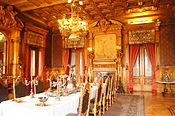



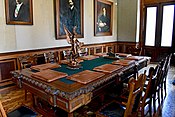

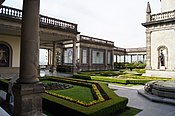


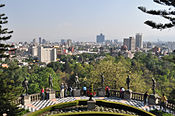
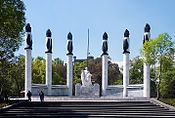
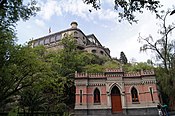


![The Valley of Mexico from Chapultepec, painting of 1850 by Casimiro Castro. Museo Soumaya.[14]during the Mexican-American War, ca. 1847 by Nathaniel Currier. Library of Congress.](http://upload.wikimedia.org/wikipedia/commons/thumb/3/30/The_Valley_of_Mexico_from_Chapultepec_%28Mexico_City%29%2C_1850_Casimiro_Castro.jpg/175px-The_Valley_of_Mexico_from_Chapultepec_%28Mexico_City%29%2C_1850_Casimiro_Castro.jpg)

![Chapultepec Castle in 1870 by Albert S. Evans.[15]](http://upload.wikimedia.org/wikipedia/commons/thumb/f/ff/0ur_Sister_Republic_-_Chapultepec_p.271.jpg/171px-0ur_Sister_Republic_-_Chapultepec_p.271.jpg)
![Chapultepec Castle in 1880 by Henry Becher. University of California Libraries.[16]](http://upload.wikimedia.org/wikipedia/commons/thumb/5/5c/A_trip_to_Mexico%2C_being_notes_of_a_journey_from_Lake_Erie_to_Lake_Tezcuco_and_back%2C_with_an_appendix%2C_containing_and_being_a_paper_about_the_ancient_nations_and_races_who_inhabited_Mexico_before_and_%2814784090803%29.jpg/175px-thumbnail.jpg)
